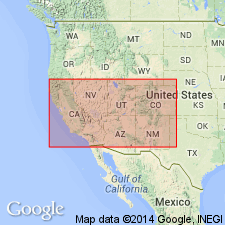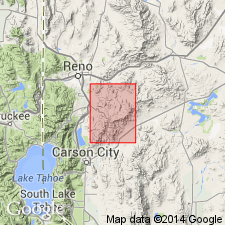
- Usage in publication:
-
- Truckee group*
- Modifications:
-
- Original reference
- AAPG geologic province:
-
- Southern Oregon basin
Summary:
Map 5 (Nevada Basin) and 1878 (US Geol. Expl. 40th Parallel Rpt., v. 1, p. 412). Truckee group. Fresh-water deposits of Miocene age consisting of coarse sands and gravels, white stratified trachytic tuff, pelagonite tuff, marly grits, some sandstones, and one 60-foot bed of sacchraroidal limestone. Large part of material is made of trachytic muds, which carry, especially in Oregon, numerous numbers of Miocene fossil mammals. The deposits are partly older and partly contemporaneous with the trachytes that are interbedded with the sediments. Thickness about 4,000 feet. Deposited in lake to which name "Pah-Ute lake" is applied. Age is Miocene. [As mapped in above-mentioned atlas the formation occurs in disconnected areas across Nevada, indicating probable deposition in several disconnected lakes. It is mapped over considerable areas in valleys east and west of south end of Truckee Range and in Truckee Canyon between Reno and Verdi, Nevada.]
Source: US geologic names lexicon (USGS Bull. 896, p. 2189).

- Usage in publication:
-
- Truckee formation*
- Modifications:
-
- Overview
Summary:
Truckee formation is used by the USGS to include deposits to which the name "Siebert formation" has been applied in some parts of Nevada.
Source: US geologic names lexicon (USGS Bull. 896, p. 2189).

- Usage in publication:
-
- Truckee formation*
- AAPG geologic province:
-
- Great Basin province
Summary:
Pg. 55-56, pl. 3. Truckee formation. Formation described Virginia City quadrangle, Nevada, where it is composed of stream and lake deposits which occur in many disconnected areas; beds of diatomite common. Thickness uncertain; may be 3,000 feet or more in Chalk Hills but much less elsewhere. Underlies Lousetown formation; base intertongues with lower part of Kate Peak formation. [Age is] early Pliocene.
Source: US geologic names lexicon (USGS Bull. 1200, p. 3965).
For more information, please contact Nancy Stamm, Geologic Names Committee Secretary.
Asterisk (*) indicates published by U.S. Geological Survey authors.
"No current usage" (†) implies that a name has been abandoned or has fallen into disuse. Former usage and, if known, replacement name given in parentheses ( ).
Slash (/) indicates name conflicts with nomenclatural guidelines (CSN, 1933; ACSN, 1961, 1970; NACSN, 1983, 2005, 2021). May be explained within brackets ([ ]).

